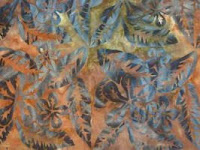Batik ... Indonesian Textile
How Batik Craft Artists Make Batik Fabric
The patterns to be dyed into the cloth are drawn with a canting, a wooden 'pen' fitted with a reservoir for hot, and liquid wax.
In batik workshops, circles of women sit working at clothes draped over frames, and periodically replenish their supply of wax by dipping their canting into a central vat. Some draw the art designs directly on the cloth from memory and others wax over faint charcoal lines. 
This method of drawing patterns in wax on fine machine-woven cotton was practiced as a form of meditation by the female courtiers of Central Java. Traditionally, batik tulis (tulis means 'write' in Indonesian) is produced by women.
19th Century Batik Method
In the 19th century, the application of waxed patterns with a large copper stamp or cap saved the batik fashion industry from competition with cheap printed cloth. You can still find these batik stamps sometimes in antique shops. 
The semi-industrial nature of cap work allows it to be performed by men. Batik motifs recall characters from the Hindu epics, plants, animals, sea creatures and gamelan melodies.
In Surakarta rich creams and browns are juxtaposed with tinges of yellowish gold.
White, undyed cloth is left to contrast with the sombre opulence of brown and blue dyes in Yogjakarta.
The colour palettes of the north coast were influenced by lively marine-trade and the textile traditions of the Chinese and Arab mercantile communities living in port and coastal towns.
 The Symbolic Meaning of Batik Motifs
The Symbolic Meaning of Batik MotifsAs in other fields of Javanese tradition the motifs of Batik material especially with older antique patterns symbolizes something. This might be one of the reasons why people still adore batik fabrics up to present date. Some of the Motifs are:
- Sido Dadi
- Satrio Wibowo
- Tikel Asmorodono
All these antique motifs have great meaning. Just as with crystals and gem stones it is thought that the woman or man wearing batik fabrics bearing these motifs will be furnished with what she or he wears.
The Cities of Batik
Yogyakarta and Surakarta are the art centres of traditional antique designs of batiks, whilst the north coastal town of Pekalongan is the centre of more modern batiks, using more floral and birds motifs.
There are some well-known artists of batik design in Jogya and Surakarta, as well as some big batik manufacturers with famous trademarks. The growing production of batik makes way to the establishment of mori (woven cotton fabrics) factories in Jogya and Central Java.


